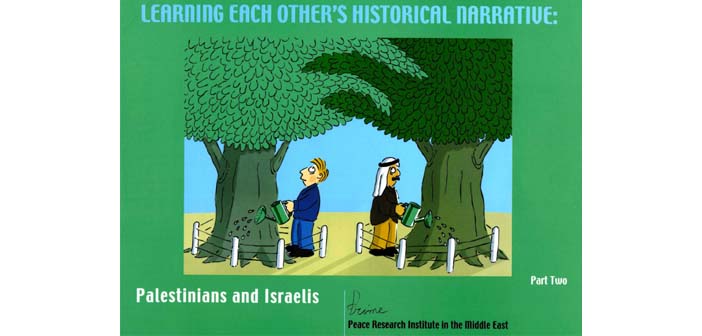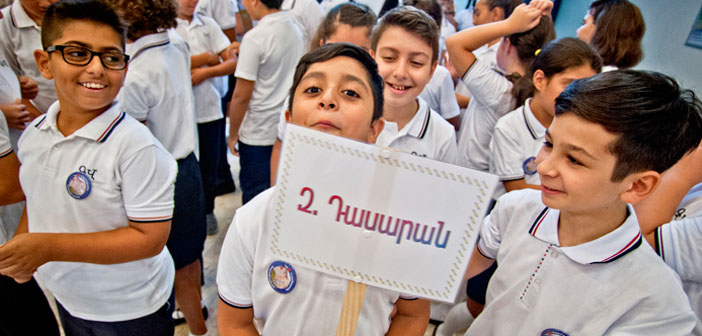With the deal made between Turkey and Israel, “humanitarian aid” to Gaza Strip is brought to the agenda once again. On the other hand, a joint Palestinian and Israeli project, which has been going on since 2002, tries to find a more permanent solution to the crisis in the region. The book titled as "Learning Each Others Historical Narrative" offers a new model for history textbooks used in Palestinian and Israeli schools. Project's co-director Sami Adwan told about this model.
"Learning Each Others Historical Narrative"
is the kernel of a long-term project, which was initiated by Peace
Research Institute in the Middle East (PRIME). Prof. Sami Adwan from
Bethlehem University is the co-director of this project and thinks
that reading the stories of others in the historical narrative can
pave the way for peace.
Can you talk about the content of this project?
This projects is going on for 14 years and we completed the book. Now, we are training teachers and other professionals on how to use the book and the importance of multiple perspectives in history teaching. Teachers should avoid teaching from a single perspective.
Why is this important?
Because there is no one history; there are many historical narratives. Above all, teaching the other perspectives than your own should be considered as a part of child's rights. For children, it is important to see the bigger picture and to have multiple perspectives. Letting children learn different historical narratives means embracing pluralism and diversity and having a critical attitude concerning history. History includes criticism, discussion and interpretation. It shouldn't be about memorizing and answering the questions in the exams.
As a Palestinian living in West Bank, what was your motive for joining this project?
I was a child, when Israel occupied West Bank during Six-Day War in 1967. I witnessed all kinds of cruelty and violence. I had been beaten and detained many times and I spent 6 months in prison. And ultimately I realized that a violent approach cannot provide a solution for clashes between Palestine and Israel. Such an approach only prolongs the clashes and causes more suffering. We need to make children understand the both sides by creating a new educational system. What we are doing is like an attempt of making it more humane. When you read the story of the other, you realize how meaningless this 60-years-old conflict is. This is both a peace building project and a model for improving education. As a Palestinian living in an occupied land, I hope that this project will influence Israeli ideology and they realize that Palestinian people living in an occupied land have perspective, history, tradition and culture of their own. I am working for creating better conditions for my children and grandchildren; better conditions compared to my childhood and today.
People should be able to access history, regardless of who is right and who is wrong. In this way, people would see each other in a new light. Enemy is the one whose story we don't know.
How is the other dehumanized in the textbooks of Israel and Palestine?
In Israeli maps, only Israel is shown. They abstain from using words “Palestinian” and “Palestine”; they use “Arabs” instead. In the textbooks, Palestinian people are portrayed not as humans, but as a crowd ready to resort to violence. In the pictures, they are shown with camels and donkeys; with this, they imply that Palestinian people are leading a primitive life. For instance, Jerusalem is defined as the capital of Israel and this amounts to ignoring the rights of Palestinian Christians and Muslims on Jerusalem. These are different ways of dehumanization.
And how are Israeli people portrayed in Palestinian textbooks?
In Palestinian maps, there is no Israel. Palestinian people define Israeli people through what they have done. For instance, Israeli people are portrayed as the ones who stole Palestinian's water and territory. In Palestinian books, holy places of the Jews are not shown or mentioned.
Is your book distributed to the schools?
Ministry of education of both sides doesn't accept the book. Some teachers and schools use it with their own accord or they recommend it to the students. As a matter of fact, not the content but the model of the book is important. I mean, when a teacher talks about a holy place for Muslims, will he also talk about its meaning for Jewish history? Or vice verse. This is what matters for us.
Is this book used in other countries?
It is translated into English, German, French and Italian and used as a model in Macedonia. It is used in some schools in France, Spain, Italy and the US. This model can be adapted to any educational system. For instance, it can be adapted to the history of northern and southern Cyprus, history of Germany and the history of Armenians and Turkey. However, unfortunately, our model is not official locally. We cannot blame them, since it is not easy for officials to accept such innovative projects. When we started this project in 2002, we thought that it will be a post-conflict project, but then, the Second Intifada took place. And we continued working, knowing that this project, which was awarded internationally, won't be accepted in our own land.
It is so sad that we won't be able to see the influence of this project on Palestinian and Israeli children. Haven't you got any feedback?
There are some teachers who used this book in Palestine and they provided feedback. They say that the reactions of the students vary. Some said, “It is good to learn the story of the other side. It encouraged me to read about my history more. Now, I have a better understanding why they behaved like that.” And some other said, “We shouldn't read them. It is confusing and full of propaganda.” Of course this is not an easy process.
What is the future of this work?
We will prepare a new book. Palestinians don't talk about Holocaust and Israelis don't talk about Nakba Day. We will make a guide book about these matters. This is a process that can be defined as “learning from the traumas of the country”. This might give an idea about human rights violations and lifting of the blockage for both sides. I hope that Palestine will be free one day and live side by side with Israel. Education will make it possible; though its process is slower, it is a better way compared to politics. Firstly, with a peace-oriented education, we can raise a generation, which won't make the same mistakes with the previous generations. Secondly, this generation might support a peace treaty. Thirdly, people might put the pressure on the governments and show them this is not the right way. Ultimately, those people will govern the future.





